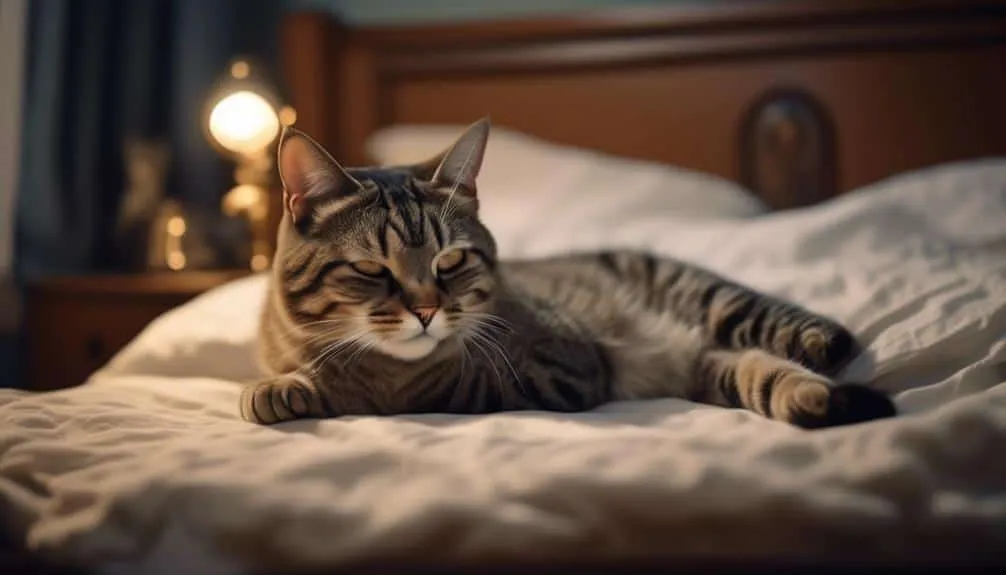The Best Fluffy Pancakes recipe you will fall in love with. Full of tips and tricks to help you make the best pancakes.

Imagine waking up to the soft touch of a furry paw on your face, only to realize that it's your cat's sneaky morning ritual. You're not alone in this experience, as many cat owners can relate to the persistent face-pawing wake-up call. While it may be frustrating, understanding the reasons behind this behavior is key to finding a solution.
In this article, we will explore the motivations behind this ritual and provide practical tips to help you modify it. So, if you're ready to discover the secrets behind your cat's morning wake-up call, let's uncover the mysteries together.
Key Takeaways
- Face-pawing in cats can be a form of communication, attention-seeking, affection, hunger, or playfulness.
- To discourage face-pawing behavior, positive reinforcement, redirecting behavior, consistency, deterrents, and professional help can be utilized.
- Health-related concerns such as eye problems, dental issues, allergies, ear infections, and skin conditions can cause cats to paw at their face.
- Environmental factors like boredom, stress or anxiety, territory marking, attention-seeking, and changes in routine can also contribute to face-pawing behavior in cats.
Reasons for Face-Pawing Behavior
Cats may exhibit face-pawing behavior for various reasons, including communication, attention-seeking, affection, hunger, and playfulness. Understanding the meaning behind this behavior can help cat owners address their feline's needs effectively.
When a cat paws at their face, it may be a way of communicating their desires or needs to their owner. They may be seeking attention, affection, or indicating that they're hungry and in need of food.
Additionally, face-pawing can be a playful behavior exhibited by cats, as they engage in interactive play with their owners or toys.
Training and Behavior Modification Techniques
As you delve into the topic of training and behavior modification techniques for addressing face-pawing behavior in cats, it's important to understand effective strategies that can be employed to redirect this behavior and promote positive changes.
Here are three key techniques to consider:
- Positive reinforcement techniques: Use treats or praise to reward desired behaviors, such as refraining from face-pawing. By providing a positive incentive, you can encourage your cat to engage in alternative behaviors and discourage the face-pawing habit.
- Redirection strategies: Provide alternative toys or scratching posts to redirect your cat's pawing behavior. By offering appropriate outlets for their natural instincts, such as scratching or play, you can redirect their attention away from their face and discourage the behavior.
- Consistency: Be consistent in enforcing boundaries and discouraging face-pawing. By consistently redirecting and rewarding alternative behaviors, you can help your cat understand what's acceptable and what's not.
Health Concerns Related to Face-Pawing
Pawing at the face in cats can be indicative of underlying health concerns. One potential health issue that may cause cats to paw at their face is eye problems. Cats experiencing discomfort or pain in their eyes may exhibit this behavior as a way to alleviate their symptoms.
Another possible health concern related to face-pawing is dental issues. Cats with dental problems, such as toothaches or gum disease, may paw at their face due to the pain they're experiencing.
Therefore, if you observe your cat frequently pawing at their face, it's important to monitor their eyes and dental health. If you notice any abnormalities or suspect a problem, it's advisable to consult a veterinarian for a thorough examination and appropriate treatment.
Environmental Factors Influencing Face-Pawing
One potential factor that can influence a cat's pawing behavior is the level of mental stimulation and environmental enrichment provided to them. Cats are intelligent creatures that require mental stimulation to keep them engaged and prevent boredom.
Here are three environmental factors that can influence a cat's pawing behavior:
- Stress relief: Cats may paw at their face as a way to relieve stress or anxiety. By providing them with a stimulating environment, you can help alleviate their stress and reduce the likelihood of face pawing.
- Boredom busters: Cats that are bored may resort to pawing at their face as a way to entertain themselves. Offering interactive toys, scratching posts, and enrichment activities can provide them with mental stimulation and prevent boredom-induced face pawing.
- Changes in routine: Cats are creatures of habit, and sudden changes in their environment or routine can cause stress or anxiety. This may lead to an increase in face pawing behavior. Minimizing changes and providing a stable and predictable environment can help reduce face pawing caused by changes in routine.
Encouraging Alternative Behaviors
To encourage alternative behaviors, provide your cat with interactive toys, scratching posts, and enrichment activities to redirect their pawing behavior and keep them mentally stimulated.
Interactive toy options, such as puzzle toys and treat-dispensing toys, can engage your cat's attention and provide mental stimulation. These toys require your cat to use their paws and problem-solving skills to access the treats, diverting their attention from pawing at their face.
Additionally, scratching posts are essential for satisfying your cat's natural instinct to scratch. By providing a variety of scratching surfaces, such as vertical and horizontal posts, you can redirect their pawing behavior to these appropriate surfaces.
Regular playtime is also crucial for reducing pawing behavior. Play sessions help expend your cat's energy and provide an outlet for their natural predatory instincts. Incorporating interactive play with toys, such as wand toys or laser pointers, can further engage your cat and redirect their pawing behavior.
Conclusion
In conclusion, understanding the reasons behind your cat's face-pawing behavior is key to addressing it effectively.
By implementing training and behavior modification techniques, addressing any underlying health concerns, and creating a stimulating environment, you can put an end to your cat's sneaky morning ritual.
So, say goodbye to those rude awakenings and hello to a more harmonious start to your day with your feline friend.








